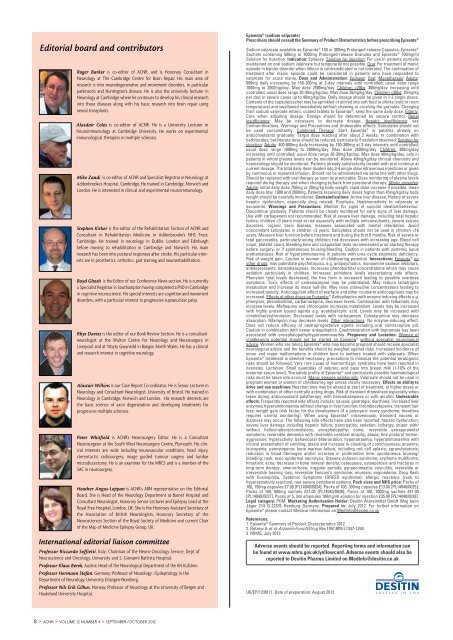Download - Advances in Clinical Neuroscience and Rehabilitation
Download - Advances in Clinical Neuroscience and Rehabilitation
Download - Advances in Clinical Neuroscience and Rehabilitation
- No tags were found...
You also want an ePaper? Increase the reach of your titles
YUMPU automatically turns print PDFs into web optimized ePapers that Google loves.
Editorial board <strong>and</strong> contributorsRoger Barker is co-editor of ACNR, <strong>and</strong> is Honorary Consultant <strong>in</strong>Neurology at The Cambridge Centre for Bra<strong>in</strong> Repair. His ma<strong>in</strong> area ofresearch is <strong>in</strong>to neurodegenerative <strong>and</strong> movement disorders, <strong>in</strong> particularpark<strong>in</strong>son's <strong>and</strong> Hunt<strong>in</strong>gton's disease. He is also the university lecturer <strong>in</strong>Neurology at Cambridge where he cont<strong>in</strong>ues to develop his cl<strong>in</strong>ical research<strong>in</strong>to these diseases along with his basic research <strong>in</strong>to bra<strong>in</strong> repair us<strong>in</strong>gneural transplants.Alasdair Coles is co-editor of ACNR. He is a University Lecturer <strong>in</strong>Neuroimmuniology at Cambridge University. He works on experimentalimmunological therapies <strong>in</strong> multiple sclerosis.Mike Z<strong>and</strong>i is co-editor of ACNR <strong>and</strong> Specialist Registrar <strong>in</strong> Neurology atAddenbrooke's Hospital, Cambridge. He tra<strong>in</strong>ed <strong>in</strong> Cambridge, Norwich <strong>and</strong>London. He is <strong>in</strong>terested <strong>in</strong> cl<strong>in</strong>ical <strong>and</strong> experimental neuroimmunology.Stephen Kirker is the editor of the <strong>Rehabilitation</strong> Section of ACNR <strong>and</strong>Consultant <strong>in</strong> <strong>Rehabilitation</strong> Medic<strong>in</strong>e <strong>in</strong> Addenbrooke's NHS Trust,Cambridge. He tra<strong>in</strong>ed <strong>in</strong> neurology <strong>in</strong> Dubl<strong>in</strong>, London <strong>and</strong> Ed<strong>in</strong>burghbefore mov<strong>in</strong>g to rehabilitation <strong>in</strong> Cambridge <strong>and</strong> Norwich. His ma<strong>in</strong>research has been <strong>in</strong>to postural responses after stroke. His particular <strong>in</strong>terestsare <strong>in</strong> prosthetics, orthotics, gait tra<strong>in</strong><strong>in</strong>g <strong>and</strong> neurorehabilitation.Boyd Ghosh is the Editor of our Conference News section. He is currentlya Specialist Registrar <strong>in</strong> Southampton hav<strong>in</strong>g completed a PhD <strong>in</strong> Cambridge<strong>in</strong> cognitive neuroscience. His special <strong>in</strong>terests are cognition <strong>and</strong> movementdisorders, with a particular <strong>in</strong>terest <strong>in</strong> progressive supranuclear palsy.Rhys Davies is the editor of our Book Review Section. He is a consultantneurologist at the Walton Centre for Neurology <strong>and</strong> Neurosurgery <strong>in</strong>Liverpool <strong>and</strong> at Ysbyty Gwynedd <strong>in</strong> Bangor, North Wales. He has a cl<strong>in</strong>ical<strong>and</strong> research <strong>in</strong>terest <strong>in</strong> cognitive neurology.Alastair Wilk<strong>in</strong>s is our Case Report Co-ord<strong>in</strong>ator. He is Senior Lecturer <strong>in</strong>Neurology <strong>and</strong> Consultant Neurologist, University of Bristol. He tra<strong>in</strong>ed <strong>in</strong>Neurology <strong>in</strong> Cambridge, Norwich <strong>and</strong> London. His research <strong>in</strong>terests arethe basic science of axon degeneration <strong>and</strong> develop<strong>in</strong>g treatments forprogressive multiple sclerosis.Peter Whitfield is ACNR’s Neurosurgery Editor. He is a ConsultantNeurosurgeon at the South West Neurosurgery Centre, Plymouth. His cl<strong>in</strong>ical<strong>in</strong>terests are wide <strong>in</strong>clud<strong>in</strong>g neurovascular conditions, head <strong>in</strong>jury,stereotactic radiosurgery, image guided tumour surgery <strong>and</strong> lumbarmicrodiscectomy. He is an exam<strong>in</strong>er for the MRCS <strong>and</strong> is a member of theSAC <strong>in</strong> neurosurgery.Heather Angus-Leppan is ACNR's ABN representative on the EditorialBoard. She is Head of the Neurology Department at Barnet Hospital <strong>and</strong>Consultant Neurologist, Honorary Senior Lecturer <strong>and</strong> Epilepsy Lead at theRoyal Free Hospital, London, UK. She is the Honorary Assistant Secretary ofthe Association of British Neurologists, Honorary Secretary of the<strong>Neuroscience</strong>s Section of the Royal Society of Medic<strong>in</strong>e <strong>and</strong> current Chairof the Map of Medic<strong>in</strong>e Epilepsy Group, UK.International editorial liaison committeeProfessor Riccardo Soffietti, Italy: Chairman of the Neuro-Oncology Service, Dept of<strong>Neuroscience</strong> <strong>and</strong> Oncology, University <strong>and</strong> S. Giovanni Battista Hospital.Professor Klaus Berek, Austria: Head of the Neurological Department of the KH Kufste<strong>in</strong>.Professor Hermann Stefan, Germany: Professor of Neurology /Epileptology <strong>in</strong> theDepartment of Neurology, University Erlangen-Nürnberg.Professor Nils Erik Gilhus, Norway: Professor of Neurology at the University of Bergen <strong>and</strong>Haukel<strong>and</strong> University Hospital.Episenta ® (sodium valproate)Prescribers should consult the Summary of Product Characteristics before prescrib<strong>in</strong>g Episenta ®Sodium valproate available as Episenta ® 150 or 300mg Prolonged-release Capsules, Episenta ®Sachets conta<strong>in</strong><strong>in</strong>g 500mg or 1000mg Prolonged-release Granules <strong>and</strong> Episenta ® 100mg/mlSolution for Injection. Indication: Epilepsy. Solution for <strong>in</strong>jection: For use <strong>in</strong> patients normallyma<strong>in</strong>ta<strong>in</strong>ed on oral sodium valproate but temporarily not possible. Oral: For treatment of manicepisode <strong>in</strong> bipolar disorder when lithium is contra<strong>in</strong>dicated or not tolerated. The cont<strong>in</strong>uation oftreatment after manic episode could be considered <strong>in</strong> patients who have responded tovalproate for acute mania. Dose <strong>and</strong> Adm<strong>in</strong>istration: Epilepsy: Oral: Monotherapy: Adults:600mg daily <strong>in</strong>creas<strong>in</strong>g by 150-300mg at 3-day <strong>in</strong>tervals until controlled; usual dose range1000mg to 2000mg/day. Max dose 2500mg/day. Children >20kg: 300mg/day <strong>in</strong>creas<strong>in</strong>g untilcontrolled; usual dose range 20-30mg/kg/day. Max dose 35mg/kg/day. Children
















